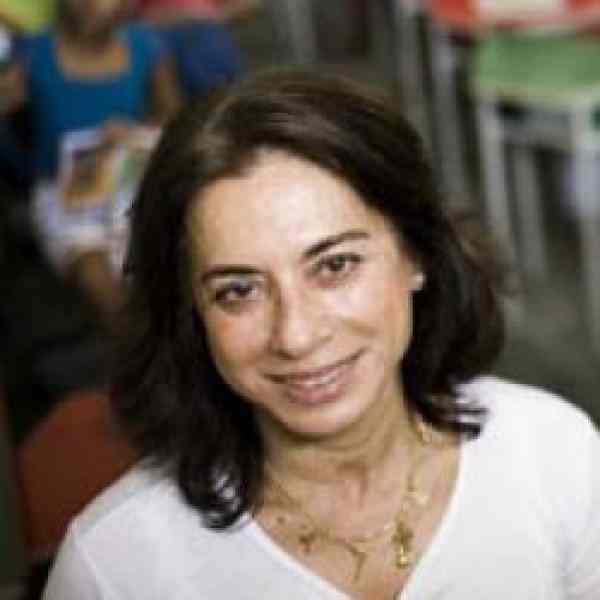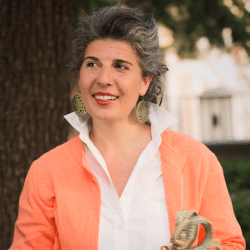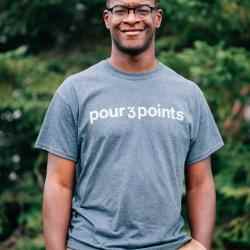Introduction
A Brazilian who worked for years in conflict zones in Africa, Yvonne Bezerra recognized the developmental delays of Brazilian children in favelas as the same as those of African children raised in the presence of civil war. Yvonne heals these children’s trauma and integrates them back into the education system so that they can grow to become full members of society.
The New Idea
Yvonne has identified a critical problem for Brazil: Children growing up in slums, or favelas, are often traumatized by violence, leading to developmental delays. She views armed conflict and other violence in the favelas as a sort of undeclared war, an environment filled with fear and stress. Yet the cognitive and learning disabilities of countless children who grow up in this environment have largely been written off as mental illness. They are thus effectively excluded from society, at risk of dropping out of school and continuing a cycle of violence in the favelas. Yvonne has developed a program and teaching methodology to heal affected children’s trauma and insert them back into the education system. She bases her methodology, which enables children to heal emotionally and regain memory and other cognitive skills, on work done in conflict zones. After they are back at regular schools, Yvonne’s organization follows and evaluates children until age fifteen. After piloting a successful demonstration center in Mare, the largest slum in Rio de Janiero, Yvonne is partnering with two public schools in Rio to teach them to replicate her model. In this way, she plans to get her model adopted by public school systems across Brazil.
The Problem
Inside Brazil’s sprawling shantytowns, the state of constant armed conflict between different criminal factions and against the police creates a state of urban violence similar to zones of war. According to research of the Brazilian Institute of Social and Economic Analysis (IBASE), the favelados (people who live in shantytowns) live under “the law of silence” for fear of the traffickers, police, and members of militias. This principally affects children and adolescents. Whereas disease was the leading cause of death five decades ago, violent deaths—most homicides—are now the principle causes of death among youth in Brazil (Waiselfisz 2007).Besides the threat to life, there are other, less apparent consequences present. One out of every five children living in shantytowns has witnessed or been affected by the death or imprisonment of a family member or a close neighbor. One in ten has been an eye witness of a killing or act of torture practiced in their presence (data obtained from interviews with children enrolling in Project Uere). These children are also deprived of a safe and healthy environment in schools. They are prohibited from crossing the invisible frontiers that delineate the territory of rival criminal factions, despite the fact that there are schools on one side with empty desks while classrooms on the other are overcrowded.Life in the presence of fear and stress, which exceeds reasonable limits in the shantytowns, provokes chemical changes in the brain that inhibit the development of children, leading to psychiatric disorders and problems with identity. Exposure to constant traumas destroys the sense of personal safety, trust in relationships with adults and family members, and contributes to the lack of affective connections with other people. The first cases of post-traumatic stress were identified after the First World War, but it was only after the Vietnam War that they were widely recognized. These problems, generated as a result of traumatic situations, are observed in countries around the world, principally those wracked with ongoing warfare. In Brazil, the public authorities and civil society have still not equated urban violence with wartime conditions, thereby ignoring the psychological and physiological consequences for thousands of children and adolescents, principally the residents of poor communities. After a trauma, children and adolescents begin to present serious learning and developmental problems, including impaired visual and auditory perception, disorganization, limited abilities of association and abstraction, memory loss, speech defects, and difficulty focusing. They are often stunted in their growth and suffer from emotional breakdowns and neuroses. They are misunderstood by the schools, which are unprepared to work with children with special needs, as well as by their families, who customarily turn to a doctor for a clinical diagnosis of the problem. But the doctors, in turn, do not know of diagnoses for these children and end up classifying them as autistic or as mentally retarded citing unknown causes. These children, stigmatized by schools, families, doctors, and the community, wind up living isolated in their homes or marginalized on the streets with extremely little chance of having a dignified and autonomous life. Developmental disabilities causes by trauma have led to an extremely high rate of children repeating years of school. According to the National Research by Domicile Sampling (PNAD), in 2005, 14.4 percent of youth aged 18 to 24 were still studying at Junior School (this should be concluded at age 15). Children who do not finish school have increasing difficulty in finding steady employment as the job market gets more competitive. This leaves children and adolescents traumatized by exposure to violence even more marginalized as adults. They are more likely to fall into patterns of crime and violence; continuing the cycle of trauma into the next generation. The denial of this scenario and the consequent lack of action and political will to resolve the problem compromises the full development of these children and the country as a whole.
The Strategy
Project Uere, the social organization created by Yvonne, is located in the complex of Mare, the largest group of shantytowns in Rio de Janeiro with 130,000 inhabitants. Project Uere makes it possible for 430 traumatized children and adolescents between the ages of three and fifteen to recover their autonomy and social life through their own initiative. As a school with open doors, the community has complete freedom and access to everyone inside Uere—from the children to the professionals. This freedom and connection with their environment is fundamental for all the children—from those used to living freely on the streets, without any routine, to those imprisoned in small homes without any stimuli for their development.At its core Uere’s model puts the individual needs of each child foremost, and is able to be adjusted with input from teachers and family members, to each student’s individual profile, capacity, and rhythm. The methodology begins with a detailed analysis which seeks to identify the exact moment of trauma and investigate the last two years of the child’s life; analyzing the family circumstances, medical history, and potential cause of the trauma. This analysis gives the teacher an insight into understanding and gaining the trust of the child and, as the next step, defining the pedagogic strategies to be utilized—books, educational games, and software, and individual and group activities. The children who start at Uere stay in a temporary class with a maximum of ten students until they can “unblock” their minds. This process generally takes six months to a year. At first, the children are able to play and do with mathematics, but most have lost the capacity to associate and have difficulty storing and accessing memories. From the beginning, the school day starts with fifteen minutes of oral exercises to help the children open up and exercise their minds. An individual and group conversation to understand the events of the previous day, such as a shooting or violence at home, is accompanied by five minutes of gymnastics to activate the blood circulation. Throughout the day, other themes are also worked on with the child including life outside of the shantytown and the possibility to reverse poverty through education, money management, leadership opportunities, art, and music. The methodology always focuses on the expression of feelings as a powerful instrument to bring back memories and deal with painful emotions.When evaluations show that students are ready, Project Uere integrates them back into the mainstream education system. Each child continues to be monitored until they reach age fifteen. Project Uere tracks their social behavior, mathematical and linguistic abilities, school grades, and their potential for inclusion in the job market. Yvonne guarantees that all the children find some kind of work when they reach fifteen years of age to show them that the dream of a new life is attainable and within everyone’s reach. The teachers, eighteen in all, are from the surrounding communities and are familiar with the situation of the children. All have been trained in the program’s methods. The teaches at Uere are paid the same salaries as public school teachers and Yvonne demands that they have a higher education diploma and seek professional qualification. Yvonne has already written twelve didactic books which are used on a daily basis at Uere. These books are financed by a Social Values Grant (Bolsa de Valores Sociais, an initiative of Ashoka Fellow Celso Grecco) and SENAC is also interested in being a partner.Project Uere is also very proud of its study grants program that enables stigmatized children to enroll in private schools, receive a high quality education and break with the stereotypes created and crystallized in the family and the community. This program proves that the intelligence of these children is intact: Ninety-five percent of the children enrolled obtained excellent results in school. The program is made possible by the support of local sponsors and currently serves seventy children.In addition to methodological innovations, Yvonne is also an innovative administrator of the organization. With the participation of twenty-two professionals, all the teachers, and the involvement of the children and their families, Project Uere administers its resources in an open manner—everyone knows the cost of each chair, the identity of the donors, and the necessary resources to close the yearly budget. The teachers are responsible for cleaning their classrooms and the cooks are trained in the pedagogic methodology. This integration has even brought about a reduction in costs proving that it is possible to provide quality education at the cost of R$85.00 per child per month. The majority of Uere’s partners are international. Yvonne insists her project will only receive private resources from known sources that share Uere’s values. This position also ensures financial independence during this stage of the project. When Yvonne is able to replicate Project Uere’s successes around the country, she hopes that her project’s high success rate and low costs per child will convince the public education system to adopt her program; given that it is in fact cheaper than paying for children to do double years in school.Yvonne is convinced it is possible for the pedagogic and management methodology she created to be passed to other professionals in an efficient and effective manner. She is preparing to systematically disseminate Uere’s pedagogic practices, teacher training techniques, and management system. Psychiatrists, doctors, and psychologists have also been consulted and, as part of the systemization process, have presented scientific evidence that the children’s minds are intact and that, with appropriate treatment, they can and will develop properly. UNICEF has shown interest in publishing these findings and Itamaraty (Ministry of External Relations) is in negotiations with Yvonne about taking the methodology to Africa.As she looks to the future, Yvonne also counts on an intense partnership with universities in the region that plan to offer Masters and Doctorates programs inside Uere. These partnerships have already made it possible for Yvonne to give special classes for students on the theme of traumatic stress pedagogy and she even taught a forty hour course on the topic at a University of Mangueira. Her intention is to include the subject of teaching children traumatized by violence in the curriculum of all education courses.One of Yvonne’s biggest objectives in duplicating Uere’s successes is to generate knowledge and data which proves that the psychological traumas caused by the violence are deeply affecting the educational development of children growing up in Brazil’s shantytowns.. Besides proving the existence of what are essentially civil wars raging in the majority of large Brazilian cities, Yvonne aspires to transform the educational system so that it can not only support traumatized children, but help them break the cycle of poverty in Brazil and in the world.
The Person
Yvonne was strongly influenced by her mother, a public employee and volunteer in various organizations, who raised her children alone. She encouraged her children to conquer life through the mind—the only thing that no one could take away from them. Yvonne grew up being discriminated against for being the daughter of a separated couple and with an income lower than that of her peers. Despite her great intellectual capacity, she never wanted to be first in class for fear of being the target of criticism and speculation of others. At thirteen, she already spent time with street children who sold comics in Copacabana and at fifteen she became an intern at the Pestalozzi Society. It was while she worked with mentally disabled children that she acknowledges becoming even more interested in the question of the human mind. In 1968, Yvonne studied in Paris (managing to get a grant to study philology) and in addition to actively participating in social movements she worked with immigrant children.In the 1970s, recently married to a Swedish diplomat, she visited various African countries as a simultaneous interpreter for an international aid agency. In Ethiopia, Sudan, Angola, Mozambique, Tanzania, and Kenya she came to better understand the correlation between violence and learning. After her separation in the 1980s she returned to Brazil with her three children. Her daily life consisted of working at the Bank of Spain during the day, taking care of her children until nine at night and then spending time on the streets of Rio with groups of children in Copacabana and Ipanema. In this time shared with the children she saw that the same symptoms of the war she’d seen in Africa influenced the learning processes of these Brazilian children. In 1989 she began to teach reading, reasoning, logic and mathematics to a group of children and adolescents in Candelaria in the central region of Rio.In 1993 there were already seventy-two children from the shantytown of Rato Molhado (Wet Rat) living in an at-risk situation. This was constantly denounced by Yvonne to the public and social organizations, but no action was taken. Then, late one night, it was one of these children who frantically called Yvonne to tell her they were dying in what was later known as the “Massacre of Candelaria”. Yvonne arrived at the scene before the journalists and pledged to expose the situation of the children and adolescents to the world and to prove their potential of recuperation. Since she knew who the killers were, Yvonne was kidnapped twice, but managed with the support of the international media and a lawyer, to bring about the first trial in Brazil in which police sat on the bench of the accused. From this moment on, Yvonne devoted herself fulltime to raising awareness of this crisis international media and creating a school without walls to continue working with the children of the Rato Molhado shantytown. She was able to work with about 200 students below a viaduct. When the shantytown was moved to the complex of Mare, Yvonne decided to move with it. In 1998 she founded Project Uere with the intention of providing a safe space for the children to learn.In 1999 Yvonne became a member of the International Human Rights Tribunal and again had the opportunity to visit various African countries and deepen her analysis. Children in contact with violence possess minds that are intact and can, with the correct methodology, become integrated back into society. A perfectionist and very thoughtful, she created, adapted, tested, and validated the methodology over the last seven years to prove that it can be taught to other professionals and disseminated throughout Brazil and the world.




